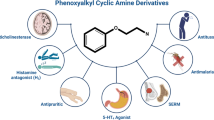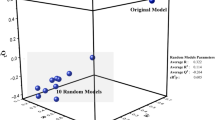Abstract
In the present work, 2-substituted benzoxazole derivatives were synthesized from 2-(benzo[d]oxazol-2-yl) aniline. All the synthesized compounds were purified and characterized by 1H NMR, 13C NMR, and mass spectroscopy. All the compounds were pharmacologically evaluated for its in vitro anti-inflammatory efficacy using membrane stabilization and proteinase inhibitory methods. In addition to this, in silico molecular docking studies were carried out to predict the binding affinity of the synthesized benzoxazole derivatives with prostaglandin H2 synthase (PGHS) protein and trypsin enzyme. The results obtained from in vitro anti-inflammatory studies showed that compound 3, 4, and 6a showed good efficacy with percentage inhibition of 74.26 ± 1.04, 80.16 ± 0.24, and 70.24 ± 0.68 for membrane stabilization activity 80.19 ± 0.05, 85.30 ± 1.04, and 75.68 ± 1.28 towards proteinase inhibitory efficacy at a concentration of 100 μg/mL which was on par to that of standards aceclofenac and etodolac. Molecular docking analysis showed that compounds 3 and 4 possess good binding affinity towards PGHS protein with a docking score of − 9.4 and − 9.3 kcal/mol respectively.










Similar content being viewed by others
References
Sondhi SM, Singh N, Kumar A, Lozach O, Meijer L (2006). Bioorg Med Chem 14:3758–3765
Vinsova J, Cermakova K, Tomeckova A, Ceckova M, Jampilek J, Cermak P, Kunes J, Dolezal M, Staud F (2006). Bioorg Med Chem 14:5850–5865
Gong B, Hong F, Kohm C, Bonham L, Klein P (2004). Bioorg Med Chem Lett 14:1455–1459
Jayanna ND, Vagdevi HM, Dharshan JC, Kekuda TRP, Hanumanthappa BC, Gowdarshivannanavar BC (2013). Journal of Chemistry 864385:1–9
Taki M, Wolford JL, Halloran TV (2004). J Am Chem Soc 128:712–713
Reena M, Kiran G, Rajyalakshmi G, Venkateshwa RJ, Sarangapani M (2010). Acta Pharm Sin 45:730–734
Kapileswar S, Sanjeev KG, Raj K, Priyank P, Vachan SM, Rohit G (2014). ACS Med Chem Lett 5:512–516
Serder U, Sultan NB, Esra K, Erdem Y (2003). Arch Pharm 336:310–321
Devinder K, Melissa RJ, Michael BR, Sean MK (2002). Bioorg Med Chem 10:3997–4004
Raok J, So Yean P (2004). Arch Pharm Res 27:1099–1105
Samia MR, Fawzia AA, Soad AME, Mona ME, Manal AS (2005). Eur J Med Chem 40:949–959
Ozlem T, Ilkay O, Esin S, Ismail Y, Nejat U (1998). I L Pharmaco 53:337–345
Youssel MA, Sherif SMA, Elkady AMA, Hamouda SES (2010). J Am Sci 6:1080–1090
Katsura Y, Inoque Y, Niishino S, Tomoi M, Itoh H, Takasugi H (1992). Chem Pharm Bull 40:1424–1438
Siddiqui N, Sarafroz M, Alam MM, Ahsan W (2008) Acta Paloniae Pharmaceutica- drug research, vol 65, pp 441–449
Jalmira M, Rudi O, Marta CJ (2010). J Med Chem 53:241–253
Klimensova V, Koci J, Waisser K, Koustova J, Dahse M (2002). Bioorg Med Chem Lett 12:3275–3278
Gurvinder S, Maninderjit K, Chander M, Saurabh P (2013). Indo Am J Pharmaceutical Res 3:6113–6118
Saritha G, Manne PK, Ambati PS, Bommalla S, Ganneboina JM, Chikoti A (2012). In J Biopharmaceutics 3:50–54
Mccarthy DM (1999). Am J Med 107:37S–47S
Richy F, Bruyere O, Ethgen O, Rabenda V, Bouvenot G, Audran M, Herrero-Beaumont G, Moore A, Eliakim R, Hiam M (2004). J Reginster Ann Rheum Dis 63:759–766
FlizGerald GA, Patrono C (2001). New Engl J Med 345:433–442
Ilkay O, Ozlem T, Ismail Y, Esin S, Nurten A (1998). Eur J Pharm Sci 7:153–160
Balaswamy G, Srinivas K, Pradeep P, Sarangapani M (2012). Int J Chem Sci 10:619–626
Silpa PS, Anny M, Jayakumar T, Suresh C, Cici M (2013). M Asian J Pharm Health Sci 3:661–670
Janardhan S, Balaswamy G, Sarangapani M (2011). Rasayan J Chem 3:588–598
Shrivastava B, Vandana S, Priyanka L (2011). Pharmacologyonline. 1:236–245
Olsen DB, Carroll SS, Culberson JC, Shafer JA, Kuo LC (1994). Nucleic Acids Res 22:1437–1443
Ghodsi GM, Alireza B, Monireh SN, Malihe H (2012). Eur J Chem 3:433–436
Flower RJ, Moncada S, Vane JR (1980) In: Gilman AG, Goodman LS, Gilman A (eds) The pharmacological basic oftherapeutics6th edn. Macmillan & Co, New York, pp 701–705
Sato S, Kajiura T, Noguchi M, Takehana K, Kobayashi T, Tsuji T (2001). J Antibiot 54:102–104
Yalcin I, Oren I, Sener E, Akin A, Ucarturk N (1992). Eur. J. Med. Chem. 27:401–406
Boeckman RK, Charette AB, Asberom T, Johnston BH (1976). J Am Chem Soc 98:1573–1578
Yadav JS, Muralidhar B (1998). Tetrahedron Lett 39:2867–2868
Chang J, Zhao K, Pan S (2002). Tetrahedron Lett 43:951–954. https://doi.org/10.1007/s11224-019-01374-1
Angajala G, Pavan P, Subashini R (2014). RSC Adv 4:51459–51470
Angajala G, Ramya R, Subashini R (2014). Acta Trop 135:19–26
Southall NT, Dill KA, Haymet ADJ (2002). J Phys Chem B 106:521–533
Chandler D (2005). Nature 437:640–647
Ball P (2008). Chem Rev 108:74–108
Reiser A, Leyshon LJ, Saunders D, Mijovic MV, Bright A, Bogie J (1972). J Am Chem Soc 94:2414–2421
Fridkin SK, Gaynes RP (1999). Clin Chst Med 20:303–316
Kim JS, Sun Q, Gatto B, Yu C, Liu A, Liu LF, La voie EJ (1996). Bioorg Med Chem 4:621–630
Perrin L, Rakik A, Yearly S, Baumbeger C, Kinloch-de Loies S, Pechiere M, Hirschel B (1996). AIDS 10:1233–1237
Staszewski S, Massari FE, Kober A, Gohler R, Durr R, Anderson KW, Schneider CL, Waterburry JA, Bakshi KK, Taylor VI (1995). Infect Dis Ther 171:1159–1165
Yalcin I, Ener ES, Ozden T, Ozden S, Akin A (1990). Eur J Med Chem 25:705–708
Hubschwerlen C, Pflieger P, SPecklin JL, Gubernator K, Gmunder H, Angehrn P, Kompis I (1996). J Med Chem 39:3375–3384
Reynolds MB, DeLuca M, Kerwin S (1999). Bioorg Chem 27:326–337
Mensor L, Menezes FS, Leitao G, Reis AS, dos Santos TC, Coube CS, Leitao SG (2001). Phytother Res 45:127–130
Acknowledgements
The authors sincerely thank the management of Kalasalingam Academy of Research and Education (KARE), Krishnankoil, Tamil Nadu, India, for their constant encouragement and support and providing all the necessary facilities for carrying out this study. The authors also thank Vellore Institute of Technology DST-VIT-FIST, SIF-VIT for carrying out NMR analysis.
Author information
Authors and Affiliations
Corresponding author
Ethics declarations
Conflict of interest
The authors declare that they have no conflict of interest.
Additional information
Publisher’s note
Springer Nature remains neutral with regard to jurisdictional claims in published maps and institutional affiliations.
Electronic supplementary material
ESM 1
(DOCX 1608 kb)
Rights and permissions
About this article
Cite this article
Angajala, G., Subashini, R. Synthesis, molecular modeling, and pharmacological evaluation of new 2-substituted benzoxazole derivatives as potent anti-inflammatory agents. Struct Chem 31, 263–273 (2020). https://doi.org/10.1007/s11224-019-01374-1
Received:
Accepted:
Published:
Issue Date:
DOI: https://doi.org/10.1007/s11224-019-01374-1




